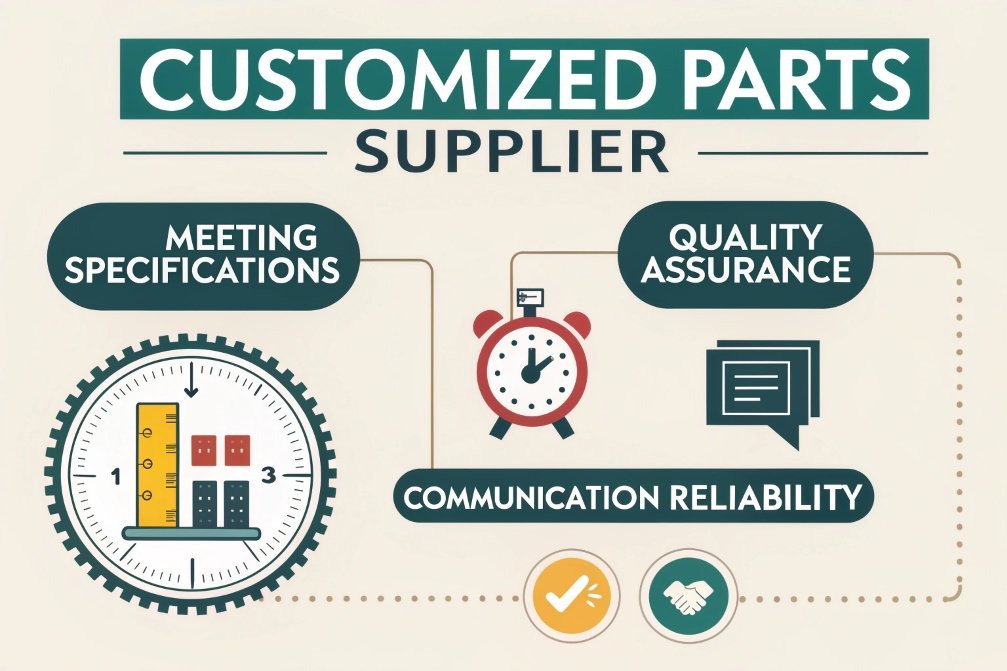
Sourcing customized metal parts comes with inherent risks that can significantly impact the production process, quality, and costs. From delays in manufacturing to subpar parts not meeting specifications, there are multiple points of failure. However, risks can be managed effectively through proper supplier evaluation, clear communication, and strong quality control practices. So, how can businesses reduce these risks when sourcing custom parts?
To reduce risks in sourcing custom parts, it’s essential to evaluate suppliers thoroughly, implement rigorous quality control systems, and effectively manage logistics and communication. A solid risk management strategy minimizes disruptions and ensures a smooth sourcing process.
Let’s explore the common risks, how to mitigate them, and why risk management strategies are crucial when sourcing customized parts.
What Are the Common Risks in Sourcing Custom Parts from Overseas?
![]()
Sourcing custom parts from overseas introduces several risks, including quality issues1, supply chain disruptions, and communication barriers2. Identifying these risks early allows businesses to take proactive steps to mitigate them.
Sourcing customized metal parts from overseas carries a number of common risks. Understanding these risks allows businesses to put in place the right safeguards and avoid costly disruptions. Below are the key risks that need to be managed:
1. Quality Issues
One of the most significant risks when sourcing custom parts from overseas is the potential for poor quality. Parts that fail to meet the required specifications can disrupt the entire manufacturing process. This risk is often caused by insufficient expertise, lack of quality control, or substandard materials used by the supplier.
2. Communication Barriers
Language differences and cultural misunderstandings can complicate the communication process, leading to mistakes in interpreting specifications, timelines, or product details. Miscommunications can cause delays, errors, and frustration on both sides.
3. Supply Chain Delays
Supply chain disruptions are another common risk when sourcing custom parts from overseas. Unexpected delays in shipping, customs clearance, or factory shutdowns can cause significant delays in production timelines, impacting the entire manufacturing process and increasing costs.
4. Currency and Payment Risks
Currency fluctuations and issues related to international payment methods are also risks when sourcing parts overseas. Exchange rate changes can lead to unexpected cost increases, and unclear payment terms can create financial issues for both parties involved.
5. Regulatory and Compliance Risks
Each country has its own set of manufacturing and regulatory standards, and sourcing from overseas can introduce risks if parts don’t meet local or international compliance requirements. Issues such as incorrect certifications, environmental standards, or safety regulations can lead to fines, legal issues, or the need for costly product rework.
| Risk Factor | Key Considerations | Mitigation Strategies |
|---|---|---|
| Quality Issues | Can the supplier meet the required specifications? | Implement rigorous quality control and regular audits |
| Communication Barriers | Are there language or cultural differences? | Ensure clear and frequent communication, and use professional translators if needed |
| Supply Chain Delays | Are there potential shipping or customs delays? | Plan for longer lead times and track shipments regularly |
| Currency and Payment Risks | How stable are exchange rates and payment terms? | Use secure payment methods and consider currency hedging |
| Regulatory and Compliance Risks | Do the parts meet international standards? | Verify supplier compliance with relevant regulations and certifications |
How Can You Mitigate Supply Chain Risks When Sourcing Custom Parts?

Mitigating supply chain risks involves identifying potential disruptions in advance and taking measures to reduce their impact. This includes diversifying suppliers, building inventory buffers, and ensuring clear communication.
Supply chain risks can arise unexpectedly when sourcing custom parts from overseas. However, there are several steps businesses can take to minimize these risks and ensure continuity. Below are strategies for mitigating supply chain risks:
1. Diversify Suppliers
Relying on a single supplier for all custom parts can create significant risks. If that supplier encounters issues—such as financial instability, labor shortages, or production delays—there could be a disruption in the manufacturing process. By diversifying the supplier base, businesses can reduce the risk of relying too heavily on any one source.
2. Build Inventory Buffers
Building inventory buffers is another effective way to mitigate supply chain risks. Maintaining a stock of critical components ensures that even if there is a delay with a particular order, production can continue without interruption. Buffer stocks act as a cushion against unforeseen supply chain disruptions.
3. Establish Clear Lead Times and Communication
Clear communication and agreed-upon lead times are essential for managing supply chain risks. Setting realistic timelines and keeping track of progress with regular updates ensures that both parties have a shared understanding of expectations. Proactive communication can help address potential delays early in the process.
4. Leverage Technology for Tracking
Utilizing technology for real-time tracking and monitoring of shipments allows businesses to stay informed about potential delays or issues in the supply chain. Software tools and tracking platforms can provide updates and alerts, enabling quick responses to problems that may arise.
5. Assess Supplier Stability and Risk Profiles
Evaluating the financial stability and risk profiles of suppliers before partnering with them is a crucial step. Assessing the supplier’s ability to manage risks and maintain operations under various conditions helps to avoid disruptions caused by supplier issues. A supplier with a stable financial background is less likely to face disruptions that could impact your supply chain.
| Mitigation Strategy | Key Considerations | Benefits |
|---|---|---|
| Diversify Suppliers | Do you have backup suppliers for critical parts? | Reduces dependency on a single supplier and mitigates the risk of disruptions |
| Build Inventory Buffers | Do you have a buffer stock for key components? | Ensures production continuity during supply chain delays |
| Establish Clear Lead Times | Are timelines clearly defined and agreed upon? | Helps manage production schedules and reduces uncertainty |
| Leverage Technology for Tracking | Can you track shipments in real time? | Provides early detection of potential delays and disruptions |
| Assess Supplier Stability | Is the supplier financially stable? | Minimizes the risk of disruptions due to financial instability |
Why Should You Implement Risk Management Strategies for Custom Parts Sourcing?

Implementing risk management strategies for sourcing custom parts is crucial for ensuring smooth, reliable, and cost-effective operations. Proactively addressing risks can help businesses avoid disruptions and maintain consistent production quality.
Risk management strategies are vital for managing the various challenges that come with sourcing custom parts from overseas. By identifying potential risks in advance, businesses can take action to mitigate them and reduce their impact. Here’s why these strategies are essential:
1. Prevent Disruptions
Risk management enables businesses to identify potential risks early and plan for them accordingly. For instance, it may be possible to find alternative suppliers in advance or build a contingency plan for potential delays, preventing disruptions to the production process.
2. Reduce Financial Losses
Unmanaged risks such as poor-quality parts, delays, or regulatory non-compliance can result in financial losses. These issues may require costly product rework, lost production time, or even legal fees. Implementing risk management strategies helps reduce these risks and their associated costs.
3. Ensure Supplier Accountability
Risk management establishes clear expectations and performance metrics for suppliers. By regularly monitoring supplier performance, businesses can hold suppliers accountable for meeting quality, delivery, and other contractual obligations. This reduces the risk of unfulfilled expectations and poor supplier performance.
4. Build Stronger Supplier Relationships
By proactively managing risks, businesses can foster stronger, more transparent relationships with suppliers. A risk management strategy provides clear communication and shared understanding, which leads to better collaboration and problem-solving with suppliers.
| Risk Management Benefit | Key Considerations | Expected Outcomes |
|---|---|---|
| Prevent Disruptions | Are potential risks identified and planned for? | Helps prevent production delays and unexpected disruptions |
| Reduce Financial Losses | Have you calculated the financial impact of risks? | Minimizes the cost of delays or product defects |
| Ensure Supplier Accountability | Are there clear expectations for supplier performance? | Reduces the risk of missed deadlines or quality failures |
| Build Stronger Supplier Relationships | Do you maintain open communication with suppliers? | Promotes long-term partnerships based on trust and reliability |
Conclusion
Reducing risks in sourcing customized metal parts requires proactive planning and a solid risk management strategy. By evaluating suppliers carefully, building contingency plans, and maintaining clear communication, businesses can mitigate common risks such as delays, quality issues, and financial challenges. Effective risk management ensures smoother operations, better supplier relationships, and higher-quality custom parts.

